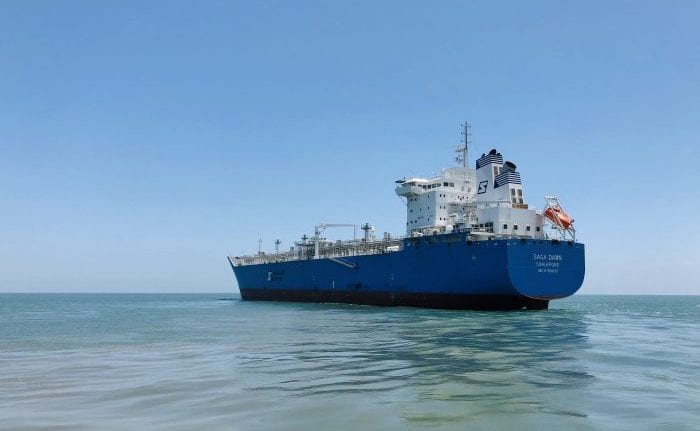Saga Dawn is the world’s first LNG Carrier featuring an IMO type A LNG containment system. The ABS-classed vessel was built at China Merchants Heavy Industry’s Jiangsu yard and features Wärtsilä dual-fuel main and auxiliary engines. Photo: Saga LNG Shipping

By Anna Shiryaevskaya (Bloomberg) –The new Saga Dawn liquefied natural gas tanker shuttling between Singapore and Humen in eastern China is a sign that the fastest-growing fossil fuel is permeating into markets once thought inaccessible.
A so-called mid-sized tanker, the ship can travel up the Pearl River to access inland markets, extending LNG’s reach beyond traditional coastal facilities. The emerging trend could unlock access to cleaner-burning fuel for remote buyers, while helping exporters grow demand in new markets. And with LNG spot prices at record lows amid a global oversupply, it’s also a cheaper solution for end-users.
The vessels, with capacity between 30,000 and 90,000 cubic meters, are being tapped for delivery to smaller Asian buyers, who don’t require a full shipment of the fuel and might just have bare-bone infrastructure. Likewise, larger vessels, the backbone of the industry, can’t enter waters near cities where demand is emerging.
Saga Dawn
“Especially in Asia and India where you have shallow waters, they cannot have large tankers going up and down these rivers,” said Sarah Behbehani, former senior vice president for LNG at Jera Global Markets. Behbehani, who has traded both oil and LNG, said she expects interest for mid-size vessels to pick up, emulating the oil side.
With capacity of 45,000 cubic meters, the Saga Dawn unloads at Jovo Energy Co.’s new terminal in Dongguan, one of the cities making up the Pearl River Delta metropolis. Singapore’s Pavilion Energy Pte Ltd. and India’s Venerable LNG Pvt. Ltd. are also looking at such vessels, which can also help LNG replace dirtier fuels in smaller, inland markets and is being increasingly used as ship fuel.
The global LNG industry developed over the past half-century by leveraging economies of scale: major players built giant production plants and equally huge vessels. Meanwhile, importers traditionally had to construct multi-billion dollar terminals to accept the fuel. But the emergence of floating storage regasification units has allowed new players to join the LNG buyers club.
The market has also become more sophisticated with cargoes being directly unloaded onto other ships, and independents such as Jovo developing their own smaller terminals and ships.
China and India are among the fastest growing LNG markets, while suppliers are also eyeing untapped demand in Southeast Asia and the Caribbean. In those situations, the key points become size of the shipments and draft — how deep the ship’s hull is submerged under the waterline.
Most traditional LNG ships have drafts up to 11.5-12 meters when full and can’t enter waterways such as the Yangtze in China, the longest river in Asia, said Oystein Kalleklev, chief executive officer of LNG shipowner Flex LNG in Oslo.
Rare Breed
At the moment, there are few such ships for these journeys. Only 8.8% of the 601 global LNG carriers are under 90,000 cubic meters, according to the International Group of Liquefied Natural Gas Importers.
“The availability of such a vessel is very rare,” said David Wu, founder and chief executive officer of Singapore-based Saga LNG Shipping, adding he has seen interest from buyers, trading houses, terminal operators and even producers for mid-sized tanker solutions. “They want to increase the use of LNG, but the problem is, not many vessels are available.”
There are only eight at the moment, but seven of them are very old, said Wu. The Saga Dawn, delivered in December and trading since April, is expected to enter a one-year charter within a month, he said.
Saga LNG will provide one or more ships for Venerable LNG’s project that targets new end users from different storage hubs in eastern India, under an accord signed May 26.
In Singapore, Pavilion Energy aims to re-export more LNG on mid-sized vessels for neighboring nations in Southeast Asia, Group Chief Executive Officer Frederic Barnaud said last year.
In the oil market, supertankers that can haul 2 million barrels — known as very large crude carriers — dominate the main longest-distance trades from the Middle East. Beneath those, there are multiple tiers of smaller vessels serving progressively more local markets.
“This is very similar to the product market for oil, where smaller parcels of refined product are transported on smaller ships to be able to berth at various smaller load ports for distribution,” Kalleklev said. “LNG is in the process of not only replacing coal, but also much more expensive diesel, so a product distribution market also needs to develop and here’s where you will find the mid-sized ships.”
–With assistance from Stephen Stapczynski and Alaric Nightingale.
© 2019 Bloomberg L.P

 Join The Club
Join The Club











